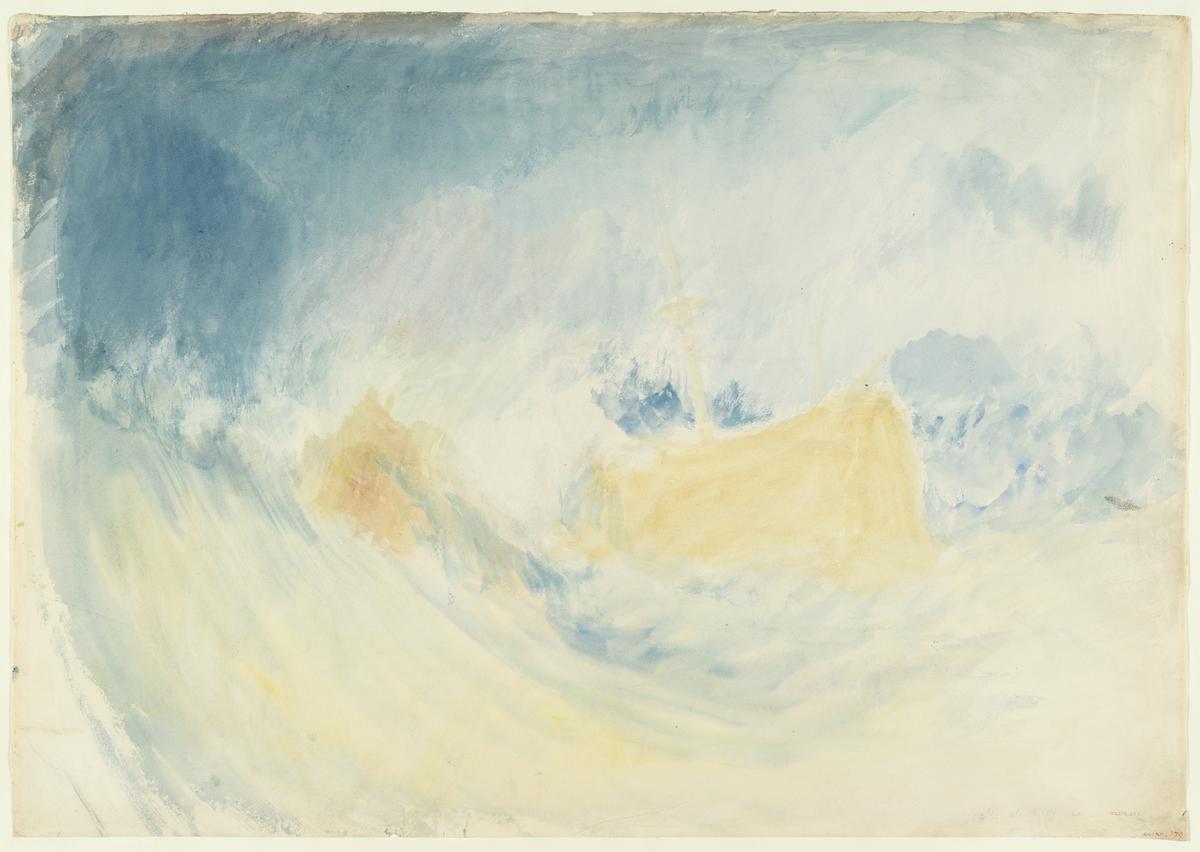Joseph Mallord William Turner A Storm (Shipwreck) c.1822-3
Joseph Mallord William Turner,
A Storm (Shipwreck)
c.1822-3
Joseph Mallord William Turner 1775–1851
A Storm (Shipwreck) c.1822–3
D25503
Turner Bequest CCLXIII 379
Turner Bequest CCLXIII 379
Watercolour on white wove paper, 388 x 484 mm
Watermark ‘J Whatman | Turkey Mills | 1822’
Inscribed by Turner in pencil ‘[...]’ towards bottom right
Inscribed in red ink ‘cclxiii.379.’ bottom right
Stamped in black ‘CCLXIII – 379’ bottom right
Watermark ‘J Whatman | Turkey Mills | 1822’
Inscribed by Turner in pencil ‘[...]’ towards bottom right
Inscribed in red ink ‘cclxiii.379.’ bottom right
Stamped in black ‘CCLXIII – 379’ bottom right
Accepted by the nation as part of the Turner Bequest 1856
Exhibition history
1931
Display of Watercolours from the Turner Bequest, lent from the British Museum, National Gallery, Millbank (Tate Gallery), London 1931–March 1934 (no catalogue).
1991
Turner: The Fourth Decade: Watercolours 1820–1830, Tate Gallery, London, January–May 1991 (8, as ‘A Storm (Shipwreck); preparatory study’, 1822–3, reproduced).
References
1820
A.J. Finberg, A Complete Inventory of the Drawings of the Turner Bequest, London 1909, vol.II, p.844, CCLXIII 379, as ‘A ship on the rocks’, c.1820–30.
1979
Andrew Wilton, J.M.W. Turner: His Life and Work, Fribourg 1979, p.358 under no.508.
1991
Ian Warrell, Turner: The Fourth Decade: Watercolours 1820–1830, exhibition catalogue, Tate Gallery, London 1991, p.29 no.8, as ‘A Storm (Shipwreck); preparatory study’, 1822–3, reproduced.
1997
Eric Shanes, Turner’s Watercolour Explorations 1810–1842, exhibition catalogue, Tate Gallery, London 1997, pp.28, 99 Appendix I ‘Marine Views Series’.
1998
Kim Sloan, J.M.W. Turner: Watercolours from the R.W. Lloyd Bequest in the British Museum, London 1998, p.86 under no.25 and note 1.
As previously recognised,1 this large ‘colour beginning’ is one of three (see also Tate D25494, D25501; Turner Bequest CCLXIII 379) painted in combinations of yellow ochre and blue on uniform sheets of 1822 Whatman paper which relate to the watercolour now customarily known as A Storm (Shipwreck) (British Museum, London);2 it was exhibited at the publisher and engraver W.B. Cooke’s gallery in 1823 (no number, added during the course of the exhibition as ‘Shipwreck’,3 but advertised as ‘A Storm’4), and related to Cooke’s short-lived Marine Views print project (see the Introduction to this section). As Eric Shanes has put it, Turner used the three variant studies to ‘set out the pictorial dynamics that would flood through the most violently tempestuous seascape ever created in watercolour’5
Ian Warrell has suggested that the subject may have been inspired in part by Turner’s sea voyage up the East Coast of England and Scotland to Edinburgh in August 1822 (see Thomas Ardill’s ‘George IV’s visit to Edinburgh 1822’ section of this catalogue), during which he made many drawings of the coast, including the very rugged stretch around Dunbar Castle in the Scotch Antiquities sketchbook (Tate D13617–D13624; Turner Bequest CLXVII 18a–23).6 The apocalyptic finished design recalls earlier works such as the painting The Wreck of a Transport Ship, of 1810 (Museu Calouste Gulbenkian, Lisbon)7 and the watercolour The Loss of an East Indiaman, c.1818 (The Higgins, Bedford),8 both featuring figures in desperate straits on the steeply tilting decks of foundering vessels; see under Tate D17178 (Turner Bequest CXCVI N) for the latter, as well as being reminiscent in early, dramatic exercises in the manner of Philip James de Loutherbourg (1740–1812), such as A Rocky Shore, with Men Attempting to Rescue a Storm-Tossed Boat of 1792–3 (Tate D00392; Turner Bequest XXIII R).
Of the three studies noted initially, this is the closest in its relatively dark and muted colouring of the sea and sky to the finished design. In other respects it is perhaps the most experimental variation, as juxtaposition of the ochre forms of the principal rock in the foreground and the stricken ship in the middle distance appear to have been reversed, as Warrell has noted,9 while the vessel appears to be in a different attitude, the loose forms of the washes suggesting that it is still relatively upright with its stern at the right.
Turner’s scrawled inscription at the bottom right is difficult to decipher; its four or five short words may be a spontaneous, portentous phrase such along the lines of ‘calls all the loss in’. He evidently found the anonymity of a distant ship at the mercy of the sea poetically evocative; compare a sheet perhaps from the late 1840s showing a shadowy, listing wreck, inscribed ‘Lost to all hope she lies | each sea breaks over a derelict | on an unknown shore’ (Yale Center for British Art, New Haven).10
Wilton 1979, p.358 no.508, as ‘The storm’, reproduced; Shanes 1997, pp.28, 99 and Sloan 1998, p.86 no.25, under the title used here.
Martin Butlin and Evelyn Joll, The Paintings of J.M.W. Turner, revised ed., New Haven and London 1984, pp.128–9 no.210, pl.213 (colour).
Verso:
Blank; inscribed in pencil ‘CCCLXIII 379’ below centre; stamped in black with Turner Bequest monogram over bottom left.
Matthew Imms
July 2016
How to cite
Matthew Imms, ‘A Storm (Shipwreck) c.1822–3 by Joseph Mallord William Turner’, catalogue entry, July 2016, in David Blayney Brown (ed.), J.M.W. Turner: Sketchbooks, Drawings and Watercolours, Tate Research Publication, February 2017, https://www

